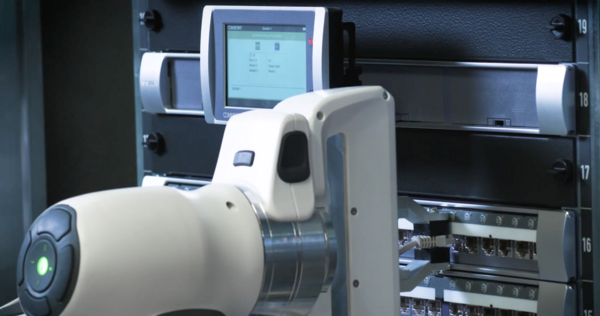
CLICK TO TWEET: Automated Infrastructure Management (AIM) Helps Bring Robots to Data Centers
In maintaining these data centers, enterprises and service providers are challenged to find enough skilled personnel to perform routine moves, adds and changes, including swapping out components and patching data cables. New deployments of edge data centers, some of which are remote, will exacerbate the personnel shortage. It has become clear that the industry needs a reliable, cost-effective solution to maintaining data centers.
As part of its ongoing effort to stay at the forefront of data center innovation, CommScope recently partnered with NTT, FNT, Cisco, Advantech and several other companies to create a robotized data center, in which mobile robots handle component swaps and cable patching. The effort, conducted as part of the ‘Robotizing Data Centers’ innovation project in the NTT Technology Experience Lab in Frankfurt am Main, Germany, involved integrating robotics, machine vision, IoT, automated infrastructure management (AIM), machine learning and AI, and other technologies.
CommScope’s contribution to the project was its ImVision AIM system. ImVision provides a real-time map of data center cable connections, giving the mobile robotic assistant the information it needs to correctly locate and patch cable connections. Using intelligent patch panels and management software, AIM systems capture the details of cabling infrastructure (type, capacity, polarity, etc.), along with automated tracking and documentation of connectivity changes. These systems “know” exactly what cables are live in the network, what speeds they support, which ports they connect, and where they are located.
In the NTT project, AIM supplies this information to FNT’s central control software, which integrates with robots and provides the intelligence the robot needs to perform its tasks. AIM enables the robot to precisely locate any particular cable and know that it is the right one. In addition, AIM’s electronic work order feature helps schedule and guide robotic tasks for implementing connectivity changes.
Moreover, thanks to the integrated machine learning algorithms, the robot system is always adding new information to its existing knowledge base, so its accuracy and efficacy grows over time. The system now exchanges hardware from different manufacturers, patches cables, and documents all changes in a transparent and unalterable format.
While the Robotizing Data Centers project is just a first step, it has successfully proven that machines can be used to perform routine maintenance tasks in central and edge data centers. As data centers become more complex and more numerous, we will likely see future robotic deployments that make data center maintenance more reliable and cost-effective.
For more information about the Robotizing Data Centers project, see NTT’s white paper here.















